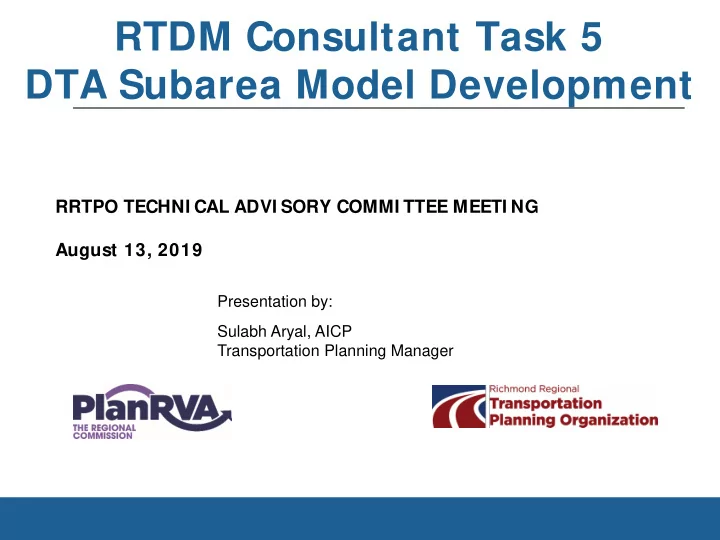

RTDM Consultant Task 5 DTA Subarea Model Development RRTPO TECHNI CAL ADVI SORY COMMI TTEE MEETI NG August 13, 2019 Presentation by: Sulabh Aryal, AICP Transportation Planning Manager 2
Objectives of the Study • To develop a mesoscopic DTA application for scenario testing • Explore the use of Big Data like Streetlight OD data/ HERE Data in the corridor-level model development • To have a deeper look of one of the major chokepoints in the region • Test applications such as freeway bottleneck analysis RICHMOND REGIONAL TRANSPORTATION PLANNING ORGANIZATION 2 2
Dynamic Traffic Assignment (DTA) Principles • Method of system-level assignment analysis which seeks to track the progress of a trip through the network over time • Accounts for formation and propagation of queues due to congestion. • A bridge between traditional regional-level static assignment models and corridor-level models (micro-simulation) • Within a model period, shorter time segments are assumed in DTA. RICHMOND REGIONAL TRANSPORTATION PLANNING ORGANIZATION 2 3
Major Chokepoints in the Richmond Region I-95 South VA-288 South US 1 to VA-161 Tuckahoe Creek Pkwy to VA-6 I-64 East US-250 to US-33 I-64/I-95/I-195 VA-288 North US-60 to VA-711 VA-76 N US-60 to VA-150 RICHMOND REGIONAL TRANSPORTATION PLANNING ORGANIZATION 2 4
DTA Study Area RICHMOND REGIONAL TRANSPORTATION PLANNING ORGANIZATION 2 5
Tools Selection and Development • Streetlight OD data and Expansion • LBS and GPS Navigation OD data within the subarea • Provides traffic flows (corridor subarea OD) using “Pass- through” zones • Expand using ODME (IPF) process, with a feedback loop within highway assignment • Develop DTA Subarea Application • Peak period specific routine • AM ( 7 AM – 9 AM) • PM (5 PM – 7 PM) • Time slice OD expanded data to 15 minute interval • Validated the model using counts and observed speed at 15 minutes interval RICHMOND REGIONAL TRANSPORTATION PLANNING ORGANIZATION 6 2
Overall Subarea Modelling Process RICHMOND REGIONAL TRANSPORTATION PLANNING ORGANIZATION 2 7
Model Calibration Congested Speed Calibration Vehicle flows Vs Counts Visual checks, Animation, Queues I-95 NB Observed Speeds I-95 NB DTA Estimated Speeds I-95 I-95 I-95 I-95 I-95 I-95 I-95 I-95 Location South South North North I-64 WB I-64 South South North of North I-64 WB End of I-64 of I-64 End Ramp WB End of I-64 I-64 End Ramp I-64 WB DIR NBO1 NBO2 NBO3 NBO4 WBO5 WBO6 NBE1 NBE2 NBE3 NBE4 WBE5 WBE6 7:00 56 56 56 58 51 51 44 44 45 50 42 53 7:15 53 54 53 54 42 42 38 16 38 38 35 48 7:30 49 48 44 47 27 27 35 8 10 38 34 49 7:45 41 37 30 36 20 20 40 6 5 38 30 38 8:00 40 36 30 36 19 19 4 5 5 38 28 25 8:15 39 35 30 37 24 24 2 4 23 38 29 23 8:30 41 38 32 36 28 28 1 4 50 38 30 17 8:45 45 42 36 39 35 35 1 4 54 54 27 16 RICHMOND REGIONAL TRANSPORTATION PLANNING ORGANIZATION 8 2
Scenarios Testing 1. No-Build/Existing Conditions 2. Scenario 1: 1 Additional Lane on I-95 NB/SB 3. Scenario 2: 1+1 Additional Lane on I-95/I- 64 Ramps 4. Scenario 3: Stress Test- Closure of I-95 SB, South of I-64 Interchange RICHMOND REGIONAL TRANSPORTATION PLANNING ORGANIZATION 2 9
Scenario 1 (1 Additional Lane on I -95) AM Period Subarea Systemwide Impacts 8L Scenario Existing Conditions > 20 mph 10-20 mph <10 mph RICHMOND REGIONAL TRANSPORTATION PLANNING ORGANIZATION 2 3
Scenario 2 (1+ 1 Additional Lane on I -95/ I -64 Ramps) AM Results- System wide: No-Build Vs. Scenario 2 RICHMOND REGIONAL TRANSPORTATION PLANNING ORGANIZATION 2 10
Scenario 2 (1+ 1 Additional Lane on I -95/ I -64 Ramps) AM Results- I-95/I-64 Interchange: No-Build Vs. Scenario 2 RICHMOND REGIONAL TRANSPORTATION PLANNING ORGANIZATION 2 11
Scenario 3: Closure of I -95 SB, South of I -64 I nterchange AM Results- System wide: No-Build Vs. Scenario 3 RICHMOND REGIONAL TRANSPORTATION PLANNING ORGANIZATION 2 12
Conclusion • Streetlight data was effectively used in developing the subarea demand, with careful OD expansion methods. • DTA calibration replicates the bottleneck conditions at the I-95/I-64 interchange • Merges of major roadways and movements • Short ramp segments • Heavy AM/PM loads • The DTA Model provides RRTPO with capabilities to analyze bottlenecks. • This approach minimized the needs for expensive data collection • Use of already available traffic count data, OD and speed data from Big data sources- Streetlight/HERE • Mesoscopic DTA model requires extensive calibration and sensitivity analysis • Delicate compromise between volume/count and congested speed calibration • Observed data should be carefully chosen for the calibration RICHMOND REGIONAL TRANSPORTATION PLANNING ORGANIZATION 2 13
Questions? Sulabh Aryal, Transportation Planning Manager saryal@PlanRVA.org 9211 Forest Hill Ave., Suite 200 Richmond, VA 23235 Phone: (804) 323-2033 www.PlanRVA.org 2
Recommend
More recommend